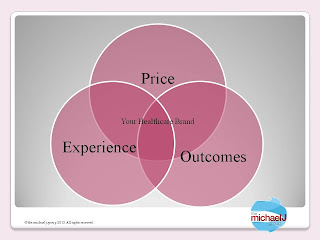How are you improving market share and revenue in healthcare?
As healthcare evolves into a consumer-centric, semi-retail market with you existing in a multitude of reimbursement schemes each nuanced for a different market segment, have you identified from a marketing perspective immediate actions to improve your market position and revenue generation? This isn't about massive advertising campaigns, gimmicks, wellness programs, etc. It’s more about getting the basics right, understanding who pays for what and how, the needs of your healthcare consumers, as well as driving demand, managing demand and moving demand to the right locations. In some circumstances it may even mean de-marketing certain services.
This is a difficult question to answer given the focus and preoccupation with hospitals and health systems, with EMR, readmissions, cost reduction, quality improvement, etc., but at the very least, it does not mean that marketing leadership cannot make a difference in their organizations, lead change and make a meaningful, measureable difference.
2. Engage existing customers and patients.
7. Turn to social media and networks to engage, manage the experience and drive adherence.
Seven step to market and revenue growth in an evolving healthcare market place. Not an impossible task, but one that does require focus. In the ends it's all about:
This is a difficult question to answer given the focus and preoccupation with hospitals and health systems, with EMR, readmissions, cost reduction, quality improvement, etc., but at the very least, it does not mean that marketing leadership cannot make a difference in their organizations, lead change and make a meaningful, measureable difference.
So very quickly, here are seven ways to improve your market position and generate revenue.
1. Brand and competitive position.
Consumers and patients are ready for convenient technology-enabled access to care. Healthcare providers that are capable of identifying their needs and how they want their healthcare needs meet though technology focused on them, will gain new patients and the next-generation of physicians. It's not a crime to use text messaging to send people information or confirmations about appointments, health reminders, or use QR codes to link to specific education or health offers.
An individual is only a patient 1/3rd of the time they come in contact with you. That is during the diagnosis, treatment and recovery phase. Pre and post this, they are a consumer not a patient. So why then is it the only time you meaningfully engage them is during the period when they are a patient? Doesn't make a lot of sense really. Consumer and patient engagement is about all of the time, not just some of the time. Engaging the individual on a continuous basis builds loyalty and return use or repurchase behavior.
3. Engage the physicians.
No matter the payment model you will still need a physicians or physician extenders order to get anything done in a healthcare setting. That means engaging physicians in meaningful ways, using the methods, technology and systems that will make their life easier, improve their productivity and protect or increase their income. An effective and efficient physician has more to do with the impact of cost and quality in your organization then you control.
4. Focus on the physician experience.
How hard is it for a physician or physician extender to practice medicine in your organization? Have you looked at the hassle factor that physicians encounter when they try to get things done in your care setting? Understand how the physician experiences your organization at every touch-point they encounter you. Understand their experiences overall from beginning to end, not just in an isolated segment. Fix what is broken, keep what is working. The more satisfying the experience, the better you will do financially.
5. Focus on the consumer/patient experience.
A healthcare provider's ability to deliver an experience that sets it apart in the eyes of its patients and potential patients from its competitors - traditional and non-traditional - serves to increase their spending and loyalty to the brand. You need to actively manage the customer experience in total by understanding the customer's point of view. That is, all touch points internally and externally that a customer/patient comes in contact with which in turn creates the experience. Exceptional experience means gains in market share, brand awareness, and revenue.
6. Embrace retail healthcare.
Traditional ways of delivering healthcare will go by the wayside in many cases. Price convenience, access and outcomes are the drivers in retail healthcare. Find the need, understand the consumer’s behavior drivers, design offering around the consumer not you in a convenient location and price it appropriately. If you can't compete in this way, your market position, share and revenue will erode.
As healthcare continues the evolution to a healthcare consumer dominated semi-retail environment, social networking is a healthcare marketing channel that is underutilized and underperforms today, but holds great potential to improve engagement, experience and adherence. And that takes healthcare marketing leadership, executive vision and meaningful action.
Seven step to market and revenue growth in an evolving healthcare market place. Not an impossible task, but one that does require focus. In the ends it's all about:
Michael J. Krivich, MHA, FACHE, PCM, is an internationally followed healthcare marketing blogger with over 5,000 monthly pages views read in over 52 countries worldwide on Healthcare Marketing Matters. These views are my own. He is founder of the michael J group, a Fellow, American College of Healthcare Executives and a Professional Certified Marketer, American Marketing Association. Like us on facebook at the michael J group, and connect with me on LinkedIn, Twitter, and Pheed



Comments
Post a Comment